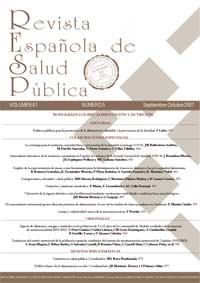Development of an Acute Myocardial Infarction Risk Adjustment Model for Spain: Comparison to the Charlson Model and the Ices Model. Application for Gauging Care Results
Abstract
Background: Acute myocardial infarction has a major bearing on morbimortality in developed countries. This study is aimed at developing a risk adjustment model for assessing the results of managing this disease and comparing how this management is carried out with other models. Methods: A risk adjustment model is developed for acute myocardial infarction by means of logistic regression with the information from an administrative database including various Spanish hospitals, taking the intrahospital mortality rate as the response variable and variables inherent to the patient proper as predictive variables. The predictability thereof is compared to the Charlson Model and the ICES model. These models are applied for assessing the intrahospital mortality rate. Results: The age (OR: 1.07), the anterolateral location (OR: 2.32) and inferoposterior location (OR:1.91), cardiogenic shock (OR:39.99), arrhythmia (OR: 94.43), cerebrovascular disease (OR:2.15) and kidney failure (OR:1.87) are shown to be related to a higher risk of death. The model developed provides a better predictability (-2LL: 2240) than the Charlson model (-2LL: 3073) and the ICES model (-2LL: 2366). There are no significant differences in the risk-adjusted death rate for the 23 hospitals studied, nor any differences between public and private hospitals nor the care volume or technological level. Coronariography (RMAR: 0.66) and percutaneous coronary interventions (RMAR: 0.69) are procedures having a protective effect. Conclusions: The model developed may be a useful tool for assessing the hospital care provided for myocardial infarction.Downloads
Published
2008-03-17
Issue
Section
ORIGINALS

